




Back to the Cornwall Page

- The Royal Connection
- Cornwall Eats
they have to be made in Cornwall, although not necessarily baked in Cornwall
they can only contain beef, potato, Swede, onion, salt and pepper. No other meat, no other vegetables, no other seasoning allowed.
there must be at least 12.5% beef and 25% vegetables in the whole pasty.
the ingredients must be raw when the pasties are assembled.
they should be shaped like a 'D' and crimped on one side, not on the top.
- Owlbut's Birdwatch
- Cornwall VIPs
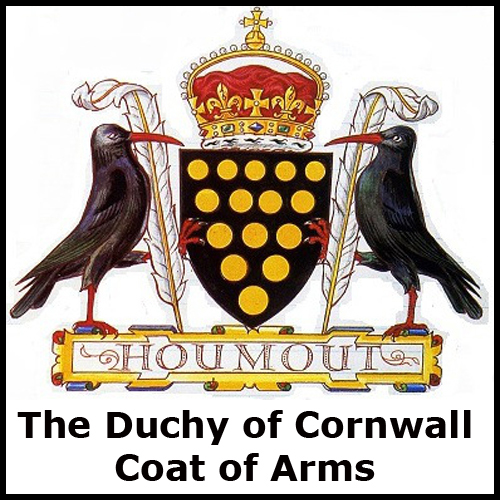 This piece was written
before the sad death of Queen Elizabeth II but I decided to leave it as written then. However, Prince William is now the Duke of Cornwll.
This piece was written
before the sad death of Queen Elizabeth II but I decided to leave it as written then. However, Prince William is now the Duke of Cornwll.
The Duchy of Cornwall
is a private estate, set up by Edward III in 1337 to provide independence to his son and heir, Prince Edward. It was the first duchy created
in England. By the way, a duchy is an area ruled by a duke. The Duke of Cornwall can only be the oldest living son of the monarch and the
heir to the throne. He must be both. Should that son die before the monarch, the title becomes part of the titles of the reigning monarch.
I thought I would make it easier for you to understand but then I got confused. If Prince Charles dies before the Queen, the
duchy should become part of the titles of the monarch but, as the title can only go to a male, it could not become part of the titles of
the reigning monarch. However the estates would come under Her Majesty's control.
Prince William would then be heir to the throne but he would not be Duke of Cornwall, as he is the monarch's grandson not son.
However, when William becomes King, Prince George would be Duke of Cornwall automatically at the same moment. However, if the Queen dies
before Charles, who then becomes King, William would immediately be Duke of Cornwall.
Just to destroy the idea that I was making this easier, if Charles had not had any children then, on his death before the Queen,
Prince Andrew would have become Duke of Cornwall as he would be the monarch's eldest living son and heir to the throne.
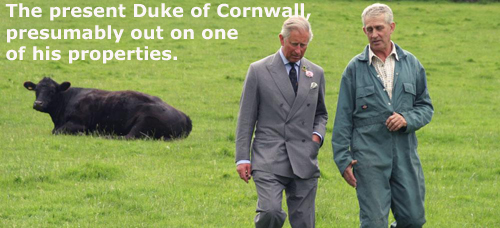 The new succession to the Crown Act of 2013
stated that those in line to the throne, born after 28th October 2011, would succeed
in age order with no preference to males. The charter granting the Duchy of Cornwall to the monarchs eldest living son and heir is not altered
by the new act.
The new succession to the Crown Act of 2013
stated that those in line to the throne, born after 28th October 2011, would succeed
in age order with no preference to males. The charter granting the Duchy of Cornwall to the monarchs eldest living son and heir is not altered
by the new act.
His Royal Highness The Prince of Wales is the 24th Duke of Cornwall and the longest serving. The shortest serving was Henry, son of
Henry VIII, who was born in November 1514, was the eldest son of Henry VIII and heir to the throne but died the same day.
The Duchy owns 126,000 acres (51,000 hectares) of land in 22 counties, roughly half of the land is on Dartmoor in Devon. Apart from
farms and small holdings, the Duchy also owns residential properties, shops and offices as well as stocks and shares. The property portfolio
includes Kennington Oval and 45 acres in Kennington itself. The Duchy is run by the Prince's Council, a non-executive board chaired by the
Prince of Wales. Day to day matters are handled by a staff of about 80 (including valets and private secretaries) and is headed by the
Secretary and Keeper of Records to the Duchy. Now you know.
![]() Back to the top
Back to the top
It didn't take much time to decide what food should go here. Cornwall is famous all over the world for the Cornish pasty. For those that don't know a pasty is a pastry package filled with meat and vegetables. However, to be a genuine Cornish pasty there are some rules to follow. In 2011 Cornish pasties were given Protected Designation of Origin (PDO) and Protected Geographical Indication (PGI) status.
The rules are as follows-:
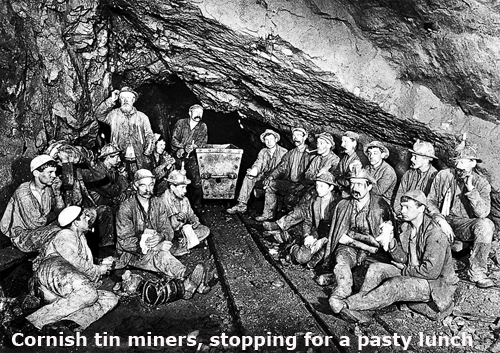 The pasties were taken for lunch
by Cornish miners and it is often said that the crimping allowed the miners to hold the pasty with dirty fingers and not touch the food they would eat. However
the pasties were often wrapped in muslin so this may or may not be true. Certainly the crimping made sure all the ingredients stayed inside the pasty. What is
more the folded pasty could stay warm for several hours, and if it did get cold, it could easily be warmed on a shovel over a lamp or even a candle. The type of
pastry used is not defined, as long as it is golden in colour, usually brushed with milk or egg, and will not crack during the cooking or cooling, although modern
pasties almost always use a shortcrust pastry.
The pasties were taken for lunch
by Cornish miners and it is often said that the crimping allowed the miners to hold the pasty with dirty fingers and not touch the food they would eat. However
the pasties were often wrapped in muslin so this may or may not be true. Certainly the crimping made sure all the ingredients stayed inside the pasty. What is
more the folded pasty could stay warm for several hours, and if it did get cold, it could easily be warmed on a shovel over a lamp or even a candle. The type of
pastry used is not defined, as long as it is golden in colour, usually brushed with milk or egg, and will not crack during the cooking or cooling, although modern
pasties almost always use a shortcrust pastry.
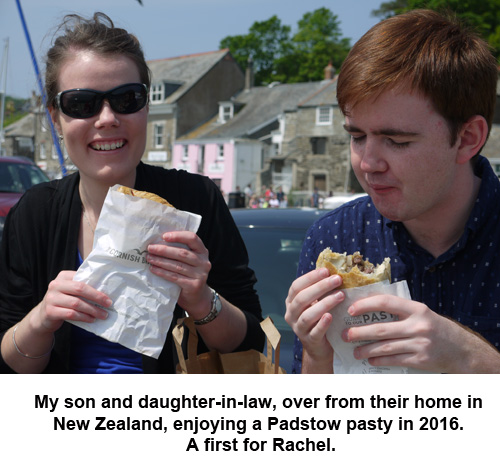 Later on some wives would make a two-part pasty with one end
filled as standard and the other end filled with a sweet filling, maybe of fruit, to
provide a complete meal. This could be why it is also said that the miners initials could be engraved in pastry on one end of the pasty so they could find their
own pasty if they didn't finish it all in one go.
Later on some wives would make a two-part pasty with one end
filled as standard and the other end filled with a sweet filling, maybe of fruit, to
provide a complete meal. This could be why it is also said that the miners initials could be engraved in pastry on one end of the pasty so they could find their
own pasty if they didn't finish it all in one go.
While the "genuine" Cornish pasty has its
set ingredients, and no others, in olden days they could be filled with all manner of scraps
and were a good source of cheap food for poor families.
Nowadays, certainly on my many visits to Cornwall, there are all manner of savoury and sweet pasties. A particular favourite of mine is chocolate
and banana although, to be honest, nothing beats a good old-fashioned, traditional Cornish pasty, providing the gulls of Padstow don't swoop down and carry it away.
At least 120 million genuine Cornish pasties are made each year.
![]() Back to the top
Back to the top
The peregrine falcon is a large powerful bird of the falcon family. It has long, pointed wings and a short tail. It is fast in
flight and very agile. Peregrines can be seen all year round, especially on rocky sea cliffs around the UK. They can be seen in winter hunting above the East
Coast marshes. They can also be seen around farmland and grassland.
Their feathers are black, grey and white. Young birds also have brown and cream colouring. They have a blackish head and a white face. Their legs are
yellow and their beaks are black and yellow, short and hooked, powerful and chunky. They eat medium-sized birds such as pigeons and small ducks,
Peregrines have been seriously endangered although they are now better protected. They have been killed because they can catch and kill game birds and
racing pigeons. People also steal their eggs for collections. Peregrines are a Schedule 1 listed species of The Wildlife and Countryside Act. There are about 1,500
breeding pairs in the UK
Peregrines are between 40 and 50 cms in length, have a wingspan between 95 and 115 cms and can weigh between 600 and 1,300 grams.
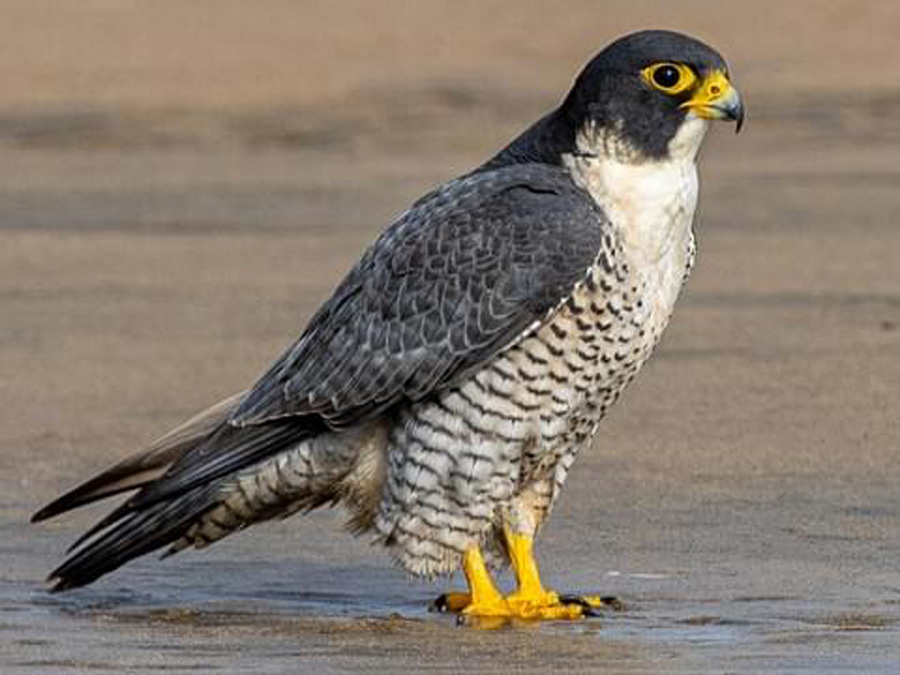
Seven random people who were born in Cornwall in the last 100 years:-
Mick Fleetwood (Musician), Dame Kristin Scott Thomas (Actor), William Golding (Author ‐ Lord of the Flies), Helen Glover (Rower ‐ Olympic
Gold Medallist), the late Charles Causley (Poet), Molly Hocking (Singer) and Nick Darke (Playwright).
![]() Back to the top
Back to the top

